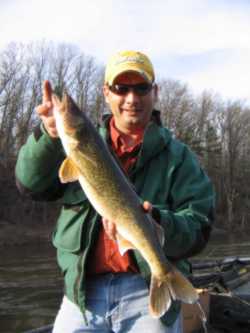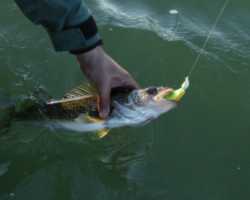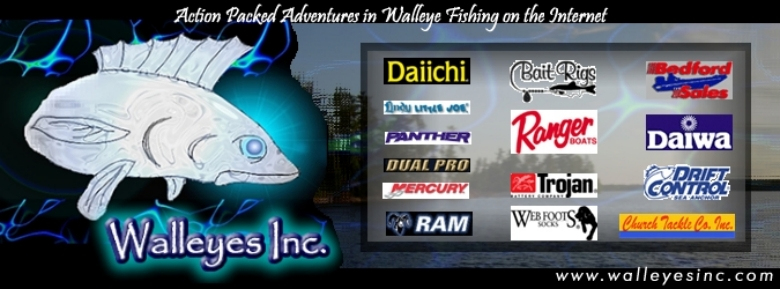Is it true that going as light as possible when fishing jigs
is the best way to go ? It sure can be but it’s not the
case all the time. Sometimes a walleye will draw in water in
a subtly manner to feed. Mostly when they aren’t actively
feeding. We all know that’s the case more often than not.
The heavier the jig the harder a fish has to draw to bring the
bait into it’s mouth. Using the lightest jig possible
in this instance is your best bet.
 |
I’ve found it’s most critical
when pitching digs in areas where there is little to no
current .In this situation fishing a slower action rod
with a soft tip works best. Complementing your soft rod
with monofilament is a good fit. You want the fish to
pick the jig up and take it in before your able to pull
it away. By lessoning the sensitivity of the line and
using a softer rod the fish has to take it more before
you will react.
Spring time on the other hand presents a common scenario.
Current is where most anglers are focusing there time.
Fisherman are looking for numbers of fish. That usually
means river systems with lots of structure. Fisherman
are targeting migrating walleye in their spawning runs.
Fish are driven by current but happy to hold up where
ever they can with out having to fit it. |
The more bottom structure the better.
When the water isn’t dirty vertical jigging is by far
the most effective presentation for fishing rivers in the spring
time. Especially when the depth varies and the bottom consist
of a good deal of structure. This by the way is some of the
best areas for holding fish. There are two keys to being effective
when jigging. The first is staying vertical and the second is
knowing exactly where your jig is in relationship to the bottom.
Other factors include rod sensitivity and line make up.
 |
Many Experts will say boat control is the
key to staying vertical and their absolutely correct.
One problem with that is you have little control over
your learning curve. Another issue is weather what if
you just can’t keep the boat under control. What
options do you have if you don’t posses good enough
boat control skills? The easiest thing to do is add weight
by using a bigger jig. It’s common for the person
controlling the trolling motor to have a good feel while
their partner is struggling to stay in tune with where
they are. The person on the motor has insight to there
next move before they make it while everyone else is flying
blind. |
A good rule of thumb is everyone in the boat uses a bigger jig
than the person on the motor.
Staying vertical does two things. The first is it keeps you
from dragging your bait into and across snags as you float with
the current. The second thing is it gives you a point to measure
from. As you set your bait down to feel bottom only to lift
it up again. Odds are your setting your bait on the structure
only to lift it over as you drift down. If your line isn’t
vertical instead of lifting up and over you’re pulling
into the structure. As you lift you can visually gage how far
from bottom you are. The most common mistake is a rapid jigging
motion with no consistency. When the fish are tight to bottom
to get out of the current random pulls lesson the time the bait
is in the strike zone. Ideally the motion you want is to just
touch bottom only to lift and hold with in six inches of bottom.
After holding the bait in place for a few moments follow your
bait to the bottom only to briefly touch to find bottom and
gage you next lift. The longer you can hold it with in a few
inches of bottom the more often the fish with see your presentation.
Unlike pitching jigs fish in current only get one look as your
presentation goes buy. Stuck tight to bottom in current breaks
walleye’s are presented with quick opportunities to decide.
This type of strike is less vulnerable to a heavier jig being
to heavy to take in. The fish is going to commit or he is going
to slash at it and short strike. If short strikes are a problem
pull out the stinger hooks. With the lifting action as apposed
to a random jigging pattern stinger hooks tangle very little.
It’s very rare that the random snapping of a jig in current
is the key to fish striking. More likely than not it’s
keeping your bait right in the fishes face for longer periods
of time.
There are other options that you can control that complement
a heavier jig. Small diameter no stretch lines such as 2-10
Power Pro. The smaller diameter line has less resistance and
transfers energy better than mono. Both together make it easier
to feel bottom. Complement that with a high modulus graphite
rod such as the 5’9” jigging rod made by Jason Mitchell
Elite series rods. Both together conduct as high of a percentage
of energy into fell as you could hope for. This can allow you
to use a lighter jig as you can feel bottom much easier. A great
advantage to this sensitive equipment is you feel the fish as
soon as your offering is touched. Allowing no delay between
when the fish bites and the feel in your hand. The only delay
you might find is with your reaction time. If that’s the
case you can keep practicing, go big or go home.
A heavier jig helps you feel bottom better, stay vertical
more often and helps with snagging less. The three of these
advantages together add up to tremendous advantages. If nothing
else you’ll loose less jigs.
Additional Suggestions
Go to a heavier jig when adding plastic bodies to your jig
when fishing current .
When water is stained or dirty add a soft plastic with a paddle
style tail like Bass Assassins Sea Shad to create vibration.
Written By Ernest Miller
Last Cast Charters
www.michiganfishguide.com
|

